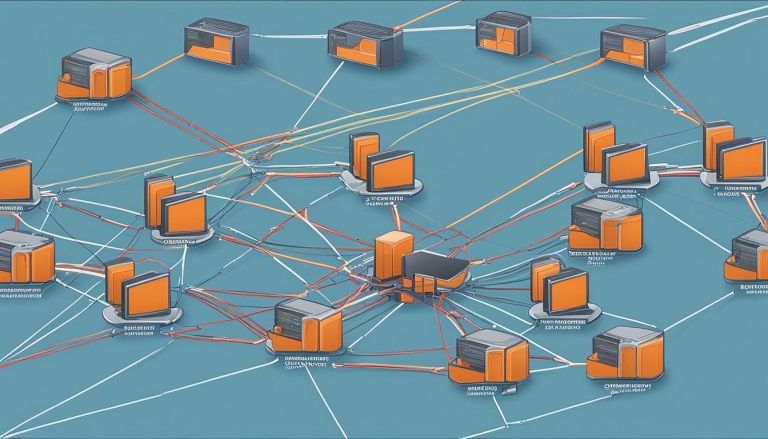Data obfuscation is a powerful technique used in the digital era to protect sensitive information from unauthorized access and potential data breaches. By deliberately modifying or obscuring data, it becomes challenging for individuals without proper authorization to understand or gain access to the information. This method plays a crucial role in maintaining data privacy, enhancing data security, and safeguarding against potential threats.
Data obfuscation can be achieved through various techniques such as data masking, data tokenization, and traditional data encryption. Each technique has its own strengths and weaknesses, and the choice depends on the specific needs and requirements of the organization. Regardless of the technique used, data obfuscation helps organizations comply with data privacy regulations, preserve data integrity, and protect valuable information from falling into the wrong hands.
Key Takeaways:
- Data obfuscation is a method of protecting sensitive information in the digital era.
- It involves modifying or obscuring data to make it difficult for unauthorized individuals to understand or access.
- Data obfuscation techniques include data masking, data tokenization, and traditional data encryption.
- Benefits of data obfuscation include data privacy, enhanced data security, and compliance with data privacy regulations.
- Data obfuscation plays a crucial role in safeguarding sensitive information and mitigating data risks.
Benefits of Data Obfuscation
Data obfuscation offers several benefits in terms of data protection and privacy. Firstly, it ensures that sensitive data remains concealed and cannot be easily understood or accessed by unauthorized individuals. This helps prevent data breaches and unauthorized data access. For example, imagine a scenario where a hacker gains access to a database containing customer information. If the data is obfuscated, the hacker would only see a jumble of characters and numbers, making it virtually impossible to decipher any valuable information.
Secondly, data obfuscation techniques help organizations comply with various data privacy regulations, such as the California Privacy Rights Act (CPRA), PCI DSS, GDPR, and HIPAA. These regulations require organizations to take necessary measures to protect sensitive data and ensure privacy. By implementing data obfuscation techniques, organizations can demonstrate their commitment to data privacy and avoid hefty fines or legal consequences.
Thirdly, data obfuscation promotes data security by making it difficult for hackers or malicious actors to decipher or exploit valuable data. With the increasing sophistication of cyber-attacks, organizations need robust security measures to protect their data assets. By obfuscating sensitive data, organizations can add an extra layer of security, making it significantly harder for attackers to gain unauthorized access or extract meaningful information. This helps safeguard against potential data breaches and financial losses.
Overall, data obfuscation is a critical component of data protection strategies and plays a crucial role in safeguarding sensitive information. By concealing valuable data, complying with privacy regulations, and enhancing data security, organizations can mitigate data risks and ensure the privacy, integrity, and availability of their data.
Table: Comparison of Data Obfuscation Techniques
| Technique | Description | Strengths | Weaknesses |
|---|---|---|---|
| Data Masking | Replacing valid data with similar characters or random numbers | – Preserves the format and length of the original data – Allows limited access to the masked data – Can be easily reversed to the original data |
– Some masked data may still be vulnerable to attacks – Data integrity may be compromised if not properly implemented |
| Data Tokenization | Replacing sensitive data with randomly generated tokens | – Preserves data type and length – Tokens have no correlation to the original data – Supports tokenization of different data types |
– Requires additional infrastructure to manage tokens – Tokenization process can be resource-intensive |
| Traditional Data Encryption | Using mathematical algorithms to convert data into cipher text | – Provides strong encryption and protection – Requires a specific key to decrypt the cipher text – Suitable for securing various data types |
– Encryption overhead can impact performance – Key management and distribution can be complex |
Techniques and Tools for Data Obfuscation
Data obfuscation employs various techniques to modify or obscure data, making it difficult for unauthorized individuals to access or understand sensitive information. These techniques, along with specialized tools and software solutions, play a crucial role in safeguarding data privacy and enhancing data security.
Data Masking
Data masking is a technique used to replace valid data with similar characters or random numbers, rendering the original data unreadable. This technique is commonly used to protect sensitive information such as social security numbers (SSNs), credit card numbers, or personally identifiable information (PII). By masking sensitive data, organizations can ensure that unauthorized individuals cannot decipher or exploit valuable information.
Data Tokenization
Data tokenization involves replacing sensitive data with randomly generated tokens while preserving the data’s format and length. This technique is commonly used to protect credit card numbers or other valuable information. By tokenizing data, organizations can secure sensitive information without compromising its usability. Even if the token is intercepted, it holds no value to an unauthorized individual since the original data cannot be derived from it.
Traditional Data Encryption
Traditional data encryption converts plain text data into cipher text using mathematical algorithms. The cipher text can only be decrypted with a specific encryption key, ensuring that only authorized individuals can access the original data. This technique is widely used to protect sensitive information during transmission or storage. By encrypting data, organizations can prevent unauthorized access or data breaches, providing an additional layer of security to sensitive information.
| Technique | Description |
|---|---|
| Data Masking | Replaces valid data with similar characters or random numbers to make the original data unreadable |
| Data Tokenization | Replaces sensitive data with randomly generated tokens while preserving the data’s format and length |
| Traditional Data Encryption | Converts plain text data into cipher text using mathematical algorithms, which can only be decrypted with a specific encryption key |
These data obfuscation techniques can be implemented using specialized tools and software solutions. One such tool is Baffle, which specializes in data protection and obfuscation. Baffle offers a comprehensive approach to data security, combining different obfuscation techniques to ensure the privacy and security of sensitive information.
By leveraging these techniques and tools, organizations can effectively protect their data from unauthorized access, potential data breaches, and comply with data privacy regulations.
Examples of Data Obfuscation
Data obfuscation techniques can be implemented in various ways to protect sensitive information and maintain data privacy. Here are some examples of how different data obfuscation techniques can be applied:
Masking Social Security Numbers (SSNs)
One common example of data obfuscation is masking social security numbers. Instead of exposing the full SSN, organizations can replace certain digits with generic values or random characters. For instance, an SSN like 123-45-6789 can be masked as 123-XX-XXXX or even scrambled into a completely random sequence like 789-21-5436. By obscuring the actual digits, it becomes challenging for unauthorized individuals to identify and misuse the sensitive information.
Tokenizing Credit Card Numbers
Data tokenization is another effective technique for data obfuscation, specifically when dealing with credit card numbers. Instead of storing actual credit card numbers, organizations can tokenize the data by assigning each card a unique randomly generated token. This token preserves the same data type and length as the original credit card number, but does not reveal any sensitive information. This way, even if the token is compromised, it cannot be used to retrieve the actual credit card number.
Encrypting Confidential Documents
Traditional data encryption is a widely used method to obfuscate confidential documents. By encrypting the data before storage or transmission, organizations can ensure that even if someone gains unauthorized access to the encrypted data, they cannot decipher the content without the encryption key. This helps protect sensitive information such as financial records, intellectual property, or personal identification data.
| Data Obfuscation Technique | Example |
|---|---|
| Data Masking | Masking SSNs by replacing digits with generic values or random characters |
| Data Tokenization | Tokenizing credit card numbers by assigning unique randomly generated tokens |
| Traditional Data Encryption | Encrypting confidential documents to protect sensitive information |
These are just a few examples of data obfuscation techniques that organizations can employ to safeguard sensitive data. By applying these methods, businesses can enhance data security, comply with data privacy regulations, and reduce the risk of data breaches and unauthorized access.
Data Privacy and Security Considerations
Data privacy and security are paramount considerations in today’s digital landscape.
With the ever-increasing volume of sensitive information being stored and transmitted online, organizations must prioritize data privacy and security to protect against potential breaches and attacks. By implementing robust data protection measures, including data obfuscation techniques, organizations can safeguard sensitive information and ensure compliance with data privacy regulations.
Data obfuscation plays a critical role in enhancing data privacy by making it challenging for unauthorized individuals to access or decipher sensitive data. It involves modifying or obscuring data in a deliberate manner, rendering it unreadable without proper authorization.
In addition to data privacy, data obfuscation also contributes to data security. By obfuscating sensitive data, organizations can thwart potential data breaches and unauthorized access attempts. This helps to safeguard critical information and maintain the integrity and trustworthiness of data assets.
Overall, data privacy and security should form the foundation of a comprehensive data management strategy. By incorporating data obfuscation techniques alongside other security measures, organizations can protect sensitive information, maintain regulatory compliance, and mitigate the risks associated with data breaches and cyber threats.
Table: Comparison of Data Privacy and Data Security
| Data Privacy | Data Security | |
|---|---|---|
| Definition | Protection of personal or sensitive information from unauthorized access or disclosure | Protecting data integrity, availability, and confidentiality through various security measures and protocols |
| Focus | Preventing unauthorized individuals from accessing or misusing sensitive data | Safeguarding data from potential breaches, attacks, or unauthorized modifications |
| Methods | Data obfuscation, encryption, access controls, consent management | Firewalls, intrusion detection systems, ransomware protection, user authentication |
| Regulations | GDPR, CCPA, HIPAA, PCI DSS | ISO 27001, NIST Cybersecurity Framework |
| Goals | Protecting individual privacy rights, minimizing the risk of data misuse | Ensuring data confidentiality, integrity, and availability |
By considering both data privacy and security, organizations can establish a strong foundation for protecting their sensitive information. This involves implementing data obfuscation techniques as part of a comprehensive security strategy, alongside other measures such as encryption, access controls, and user authentication.
Together, these efforts can help organizations comply with data privacy regulations, mitigate the risks of data breaches, and safeguard the privacy and security of sensitive information.
Conclusion
Data obfuscation is a critical strategy for organizations looking to protect sensitive information in the digital era. By employing techniques such as data masking, tokenization, and traditional encryption, businesses can enhance data privacy and security.
With the ever-increasing risks of data breaches and cyber-attacks, safeguarding sensitive information has become paramount. Data obfuscation ensures that unauthorized individuals cannot easily access or comprehend valuable data, mitigating the potential for breaches and unauthorized access.
Moreover, data obfuscation enables organizations to comply with data privacy regulations, safeguarding customer trust and avoiding legal consequences. By implementing robust data protection measures, including data obfuscation, businesses can effectively mitigate data risks and protect sensitive information from potential threats.
In conclusion, data obfuscation plays a crucial role in maintaining data privacy and enhancing data security. As organizations continue to prioritize data protection, the effective implementation of data obfuscation techniques is essential to capitalize on the potential of data while ensuring the privacy and security of sensitive information.
FAQ
What is data obfuscation?
Data obfuscation is a method of protecting sensitive information by deliberately modifying or obscuring data to make it difficult for unauthorized individuals to understand or access.
What are the benefits of data obfuscation?
Data obfuscation offers several benefits, including maintaining data privacy, enhancing data security, protecting against data breaches, ensuring compliance with data privacy regulations, and preventing unauthorized data access.
What are the techniques and tools for data obfuscation?
The most common techniques for data obfuscation include data masking, data tokenization, and traditional data encryption. Tools such as Baffle can be used to implement these techniques.
Can you provide examples of data obfuscation?
Examples of data obfuscation techniques include masking sensitive data like social security numbers (SSNs) or credit card numbers, replacing them with generic values or random digits. Tokenization can be used to protect credit card numbers by replacing them with randomly generated tokens. Traditional data encryption can be applied to any type of sensitive data, converting it into cipher text that can only be decrypted with the corresponding key.
Why is data privacy and security important?
Data privacy and security are critical for protecting sensitive information from data breaches and unauthorized access. Implementing data obfuscation techniques is an essential part of ensuring data privacy and security.
Cathy is a senior blogger and editor in chief at text-center.com.


